This website has been archived from TrainWeb.org/gyra to TrainWeb.US/gyra.
This website has been archived from TrainWeb.org/gyra to TrainWeb.US/gyra.
This light unit was used by the Santa Fe and the D&H PAs which were formerly SF PAs.
The ATSF 347C locomotive, located at the California State RR Museum is an F7A-F3B unit.
This unit has a 72 volt - 1/6 HP Delco motor which rotates the plate bearing the red-white bulbs. Power is supplied by 3 slip rings (one for: red/white/ground) to the bulbs. The plate bearing the bulbs is driven by a shaft at its midpoint. The bulb plate on both sides of this midpoint is inclined inward. This plate is rotated by the motor to produce a circular beam sweep pattern. The 1/6 HP motor does not have any gearbox. The red lens is held in place over its bulb by retaining clips which are attached to a metal ring on the other side of the lens. This is in turn attached to the bulb plate by bolts along the ring. The clear bulb is mounted with a Pyle-National hinged bulb ring and lock-down.
The red glass used is the Pyle-National glass. This glass is the best suited for this application. The glass of the Pyle is supported uniformly on the circumference of the bulb. A Mars glass would be pressed at the middle of the bulb (point of contact) without uniform support.
The plate on which the bulbs are mounted has been bent on one side - probably in the course of maintenance or bulb replacement. On inspection of the plate and clearance to "porthole" glass of the headlight opening, there was 6". On inspection of the Pyle bulb ring and mounting of the Red glass retainer, it looks like the bulbs COULD be replaced without removing the mounting bolts holding the motor base to the support. There were three 2" bolts holding the retainer ring. This ring has clips which secure the red glass to this ring. The bolts affix the red glass and underlying bulb to the bulb mounting plate. One of these bolts had a wing nut. I assume these MAY have all been wing nuts for ease of removal, originally (speculation). [These "bolts" may be threaded shafts attached to the retaining ring. These may be welded on or are countersunk screw heads. Either way, the red glass rests flush on the ring.]
Information on Motor Tag:
Delco 11 Motor
* "11" - looks like 2 "1s" stamped on plate.
Model: A 732
Serial: G-61
72 Volts DC
2.5 Amps
1/6 HP
1350 RPM
55°C Rise
Compound Wound
The 1350 RPM -- The "3" was only visible on the bottom due to stamping distortion of top. The bottom did not look like the "5" so it is assumed to be "3". This is quite interesting. 1350 RPMs would be too fast to produce the "startling effect" of a strobe - or the Gyralites - or Mars Lights. This RPM is 22.5 x per second which is high. The light rotates apparently in the range of 60 rpm or perhaps less which conforms with other oscillating lights to produce the "flash effect" warning signal. The motor is directly coupled to the bulb plate. There is the possibility that voltage dropping resistor(s) are used to decrease the voltage to this 72-volt motor thereby decreasing the rpm of the light.
There are weights attached to the "clear" bulb end of the rotating plate to help counterbalance the red glass on the opposite side.
The "Rise" indicates the temperture that the windings inside heat increase on operation of the motor. An increase of 55° C is stated for this motor.
Using a hand level and ruler, the upward tilt of the light support was determined to be 4° - with a possibility of it being 5° due to irregularities in the support and motor base. A plumbed line at the rear of the motor also showed this inclination. The red glass covered bulb could be brought into a vertically plumb position at its hightest point. The bulb without the glass (clear) could be brought into an "average" vertically plumb position. It was bent forward, with the resulting beam being directed into the track at some distance ahead of the locomotive. This could have been due to distortion. The angle between the two inwardly directed bulb plate halves was measured as 160°. This could be in error due to the distortion of the bulb plate on the non-covered (clear) bulb side. Ideally, for an upward inclination of the light mechanism of 5°, the angle should theoretically be 170°. This would give the "straight-ahead, parallel to the tracks" directed beam ath the bulb's highest position. The beam pattern would be circular as projected. For a 5° setup, this would produce a 10° circle for the centerline. Using 4° beam spread bulbs, this would result in a 14° circular path. Since the light mechanism is inclined upwards, the beam pattern would have elliptical properties on being projected onto a vertical plane (perpendicular to tracks).
In order to determine anything further on the angular relationship of the beam pattern, a laser pointer or light meter with a screen would have to be used.
An increase in the inward bend of either half of the bulb plate over the angle of the inclination upward of the light mechanism, would result in a greater angle of the beam directed upward and to the sides but a void down the center of the tracks (1° in 800 ft. = drop of 14 ft.).
Headlight in 347C:
14595-D Pyle-National
The senior curator of the museum told me that the restoration or preservation intent is to maintain the unit near its last FRA operable condition. The rotation of the light was assessed as being "slow" on an evalution of the light's operation by the museum. There is perhaps a problem with the motor in not being able to attain the designated RPM.
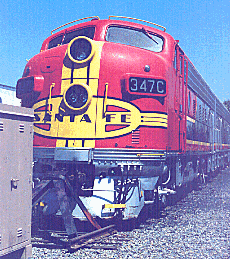
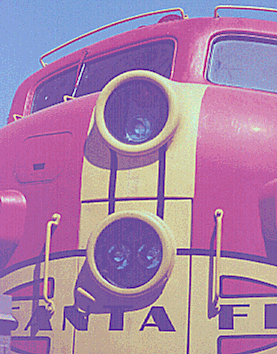
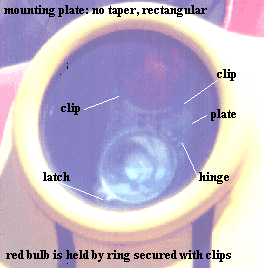

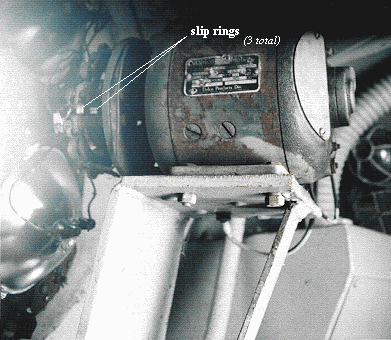
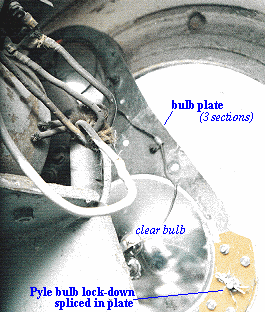
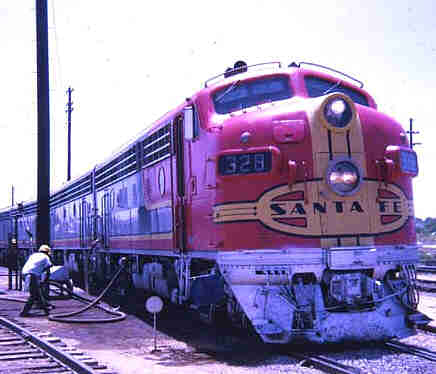
ATSF No. 328 F7A with illuminated Rotating Light in upper headlight opening in nose
photo by: Brian Ehni
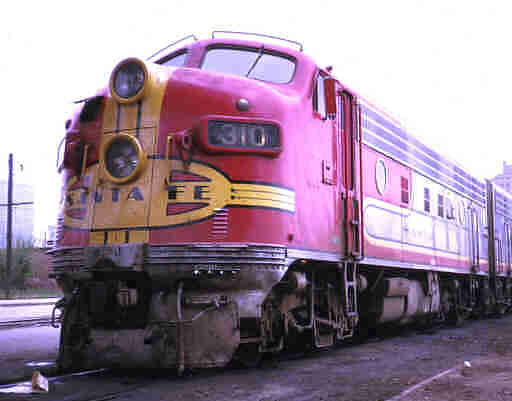
ATSF No. 310 F7A with Rotating Light in upper headlight opening in nose
photo by: Brian Ehni

"crop" of above photo showing Rotating Light bulb plate inclined to vertical axis